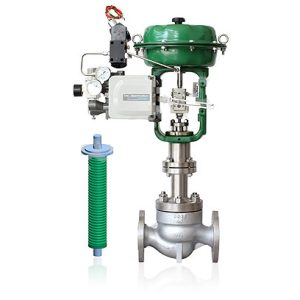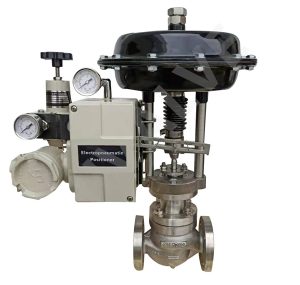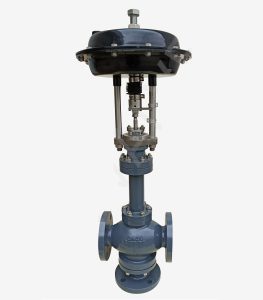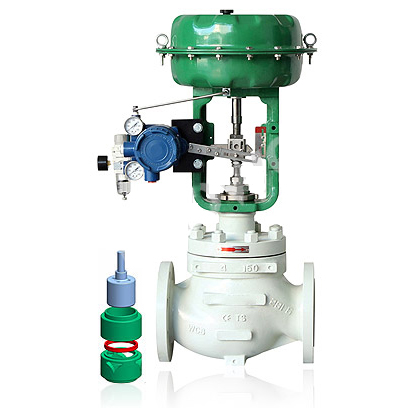Properly sizing a control valve is essential for maintaining efficiency, safety, and performance in steam systems. A Steam Control Valve plays a vital role in regulating steam flow and ensuring optimal system operation. Whether it’s a steam flow control valve, steam pressure reducing valve, or steam pressure regulating valve, accurate sizing ensures precise control of pressure and flow. Incorrect sizing can lead to significant issues like energy losses, pressure instability, or even equipment damage, compromising the entire process. For engineers and technicians, understanding critical factors such as flow rate, pressure drop, and valve capacity is integral to achieving reliable performance. This guide will outline the steps and considerations needed to select the right control valve for your steam application.
Introduction control valve
Control valves are critical components in steam systems, designed to regulate both pressure and temperature for efficient operation. From maintaining consistent pressure levels to handling thermal variations, these valves ensure the system runs smoothly and safely. Options like the Pneumatic diaphragm control valve and Pneumatic globe valve offer precise control, making them ideal for various steam applications. Pressure regulating valve manufacturers and suppliers of temperature regulating valves provide a wide range of solutions tailored to different system needs. Selecting the appropriate valve type is essential to achieving reliable performance and minimizing energy losses. Collaborating with trusted manufacturers ensures proper valve sizing and material compatibility, delivering optimal results for complex industrial processes.
Key Considerations for Control Valve Sizing
Accurate control valve sizing is essential to ensure the efficiency and safety of steam systems. Key factors like steam flow rate, pressure drop, and system temperature must be carefully analyzed, as these directly affect the valve’s ability to perform. A deep understanding of the process conditions and the unique characteristics of the steam system is crucial for making the right selection. Proper calculations, combined with the use of manufacturer-provided tools, help verify the correct control valve sizing. Missteps in this process can lead to energy inefficiency, equipment damage, or operational downtime. Collaborating with industry experts ensures optimal performance and long-term reliability.
Importance of understanding steam properties such as flow rate, pressure, and temperature.
Understanding steam properties like flow rate, pressure, and temperature is fundamental when sizing a control valve for steam systems. These parameters determine how the valve will perform under varying operating conditions, directly affecting efficiency and reliability. Fluctuations in flow rate or pressure can strain the control valve, while inaccurate temperature handling may compromise system safety. Neglecting these key properties risks inefficiencies, energy losses, equipment wear, or even system failures. Precise measurement and analysis of these steam characteristics ensure the control valve is compatible with the system’s demands, enabling smooth operation and long-term success in industrial applications.
Role of process conditions in determining the appropriate control valves.
Process conditions, including operating pressure, temperature, and flow requirements, are critical in selecting the appropriate control valve for steam systems. These variables dictate the valve’s material, design, and size to ensure seamless compatibility with the system’s operational environment. A control valve must align with specific process demands to regulate steam effectively, maintain efficiency, and safeguard system integrity. Ignoring these conditions can lead to issues such as reduced performance, energy inefficiencies, and premature equipment wear. By prioritizing a thorough understanding of process conditions, engineers can ensure the control valve delivers reliable, long-term performance tailored to the steam system’s unique requirements.
How piping configuration impacts control valve selection and performance.
Piping configuration plays a vital role in control valve selection and performance for steam systems. Factors like pipe diameter, length, and layout directly influence flow dynamics and pressure drop, critical parameters for determining valve efficiency. If the piping setup is not properly considered, the control valve may face increased turbulence or improper flow, leading to higher wear, energy losses, or operational instabilities. Ensuring the valve is optimized for the specific piping design allows it to operate as intended, maintaining smooth steam regulation and system efficiency. Careful assessment of piping configuration mitigates risks and enhances the overall functionality of the steam system.

Steps for Sizing a Control Valves
Sizing a control valve for steam involves several critical steps to ensure optimal performance. First, collect detailed system data, including operating pressure, temperature, and flow rate. Use this information to calculate the flow coefficient (Cv), a key metric for determining valve capacity. Next, select a valve type that aligns with the system’s operational demands and steam characteristics. Manufacturer tools and software are invaluable for validating these calculations and refining valve selection. Collaboration with experts is essential for addressing complex requirements and achieving precise results. This systematic approach ensures the control valve is tailored to the steam system’s unique needs, enhancing efficiency and reliability.
Gather operating parameters such as steam pressure and flow rate.
Collecting accurate operating parameters like steam pressure, flow rate, and temperature is a critical first step in sizing a control valve for steam systems. These parameters provide the foundation for selecting a valve that matches the system’s operational demands. Precise data ensures the valve is compatible, optimizes steam regulation, and maintains efficiency. Neglecting or miscalculating these parameters can lead to improper valve sizing, resulting in energy loss, equipment damage, or even system failure. Utilizing reliable measurement tools and techniques minimizes errors, enabling a well-informed selection process that enhances the system’s performance and ensures long-term operational stability.
Calculate the flow coefficient (Cv) needed for the control valves.
Calculating the flow coefficient (Cv) is a key step in selecting the right control valve for steam systems. Cv measures the valve’s capacity to pass fluid, reflecting how it handles specific flow rates under given pressure drop conditions. It is determined using critical parameters such as steam flow rate, system pressure drop, and fluid properties. Accurate Cv calculation ensures the valve matches the operational demands of the system, promoting optimal performance and energy efficiency. Miscalculating Cv can lead to underperforming valves, excessive energy consumption, or even system malfunctions, making precise calculations vital for reliable and efficient steam system operation.
Select the control valve type based on system requirements (e.g., globe, butterfly, or diaphragm valves).
Selecting the right control valve type for a steam system depends on the system’s specific operational requirements, such as pressure, temperature, and flow characteristics. Globe valves are ideal for precise control and high-pressure applications, offering reliability in regulating steam flow. Butterfly valves are preferred for their compact design and efficiency in managing larger flow capacities with lower pressure drops. Diaphragm valves are well-suited for processes requiring tight shut-off and minimal leakage. Matching the valve type to the system’s demands ensures effective steam regulation, energy efficiency, and long-term performance. Choosing an inappropriate valve can lead to inefficiencies, equipment strain, or system failures.
Validate calculations using control valve sizing tools provided by manufacturers.
Validating control valve sizing calculations with manufacturer-provided tools is essential for ensuring optimal performance in steam systems. These tools incorporate detailed valve characteristics and system parameters, providing a precise assessment of the chosen valve’s suitability. By using these resources, errors in manual calculations are minimized, leading to better valve selection and improved steam regulation. This validation process helps optimize the system’s efficiency and reliability while preventing potential mismatches. Neglecting to verify calculations risks poor valve performance, increased energy consumption, or operational failures. Utilizing these advanced tools ensures well-informed decisions, safeguarding the long-term functionality of the steam control system.

Common Challenges in Control Valve Sizing
Control valve sizing for steam systems comes with several common challenges that can affect performance and reliability. These include inaccurate data collection, misinterpreting critical system parameters like pressure and flow rate, and selecting valve types that do not align with operational needs. Such issues can lead to inefficiencies, frequent maintenance, or even failures in system operation. Overcoming these challenges requires precise system analysis, collaboration with experienced professionals, and the use of advanced sizing tools to validate decisions. Addressing these obstacles effectively ensures accurate valve sizing, enhancing the overall efficiency and stability of the steam system while minimizing operational risks.
Misjudging steam flow requirements and pressure drops.
Misjudging steam flow requirements and pressure drops can significantly compromise the effectiveness of control valve sizing. Underestimating or overestimating these parameters often results in selecting valves that are either too large or too small, leading to inefficiencies, unstable system performance, and increased energy consumption. Incorrect assumptions can also contribute to excessive wear and maintenance costs or even system malfunctions over time. To avoid such issues, precise calculations and a thorough analysis of operational conditions are critical. Leveraging reliable data, along with expert input, ensures the chosen valve aligns with the system’s needs, delivering optimal control and long-term reliability.
Overlooking the impact of operational variances on the control valve’s performance.
Ignoring operational variances, such as fluctuations in temperature, pressure, and flow rates, can severely undermine the performance of a control valve in a steam system. These variations may lead to reduced efficiency, accelerated wear, or even premature valve failure, compromising system stability. Overlooking these factors during the sizing process risks selecting a valve that performs inadequately under real-world conditions. To mitigate these issues, it is essential to incorporate a thorough analysis of operational variances into the sizing process. Engaging experts and leveraging advanced tools ensures the valve is designed to handle fluctuations, delivering consistent performance and reliability over time.
Selecting a control valve incompatible with system materials or configurations.
Choosing a control valve incompatible with the system’s materials or configurations can cause serious issues, including corrosion, leaks, or mechanical failures. Such mismatches often compromise the integrity of the valve and the entire system, leading to performance inefficiencies and costly repairs. For steam systems, ensuring that the valve’s materials can withstand the operational conditions—such as high temperatures and pressure—is critical to avoiding premature wear or failure. Proper alignment with system configurations is equally essential to maintain functionality. Conducting a thorough system analysis and consulting with industry experts helps prevent these risks, ensuring the control valve delivers lasting, reliable performance.
Helpful Tips for Effective Control Valves Selection
Effective control valve selection for steam systems requires a thorough understanding of system demands, including flow rate, pressure, and temperature. Start by using manufacturer-provided sizing tools and data sheets to match valve specifications to operational requirements accurately. Ensure material compatibility to handle extreme steam conditions and reduce the risk of corrosion or wear. Think ahead by factoring in maintenance accessibility and potential future system upgrades. For complex setups, consult industry experts to address unique system dynamics and optimize valve performance. Taking these steps ensures the selected valve operates efficiently, maintains reliability, and supports long-term system functionality.
Collaborate with control valve manufacturers and industry experts for precise sizing.
Collaborating with control valve manufacturers and industry experts is essential for achieving precise valve sizing in steam systems. Their in-depth knowledge helps address complex system requirements, ensuring material compatibility and optimized performance. By working closely with these professionals, you gain access to advanced sizing tools and technologies, enabling accurate decisions that enhance efficiency and reliability. Proactive communication allows for tailored solutions to unique challenges, such as fluctuating operational parameters or future system upgrades. Leveraging their expertise ensures that the selected control valve meets both current and long-term needs, reducing risks while supporting the seamless operation of your steam system.
Regularly assess the control valve’s operational efficiency to identify potential issues.
Routine evaluations of a control valve’s operational efficiency are vital for maintaining a steam system’s performance. Regular assessments can uncover signs of inefficiency, wear, or malfunction, enabling timely interventions before minor issues escalate into major failures. This proactive approach not only extends the lifespan of the valve but also minimizes downtime and ensures consistent system operation. Incorporating a structured maintenance schedule and leveraging diagnostic tools can help monitor valve health and detect potential problems early. By prioritizing regular checks, you safeguard the system’s reliability, optimize performance, and reduce the risk of costly disruptions or repairs.
Use advanced software tools to analyze and simulate control valve performance.
Advanced software tools are indispensable for analyzing and simulating control valve performance in steam systems. These programs provide detailed insights into how a valve operates under varying pressures, temperatures, and flow scenarios. By simulating these conditions, potential performance issues can be identified early, enabling designers to make informed sizing and selection decisions. Leveraging these tools ensures optimal compatibility with system requirements while enhancing overall efficiency and reliability. Simulations also offer predictive outcomes, minimizing risks associated with incorrect valve choices. Integrating advanced analytical technologies into the selection process helps achieve precise operations, reducing downtime and improving long-term system performance.

FAQ control valve
Q1: What factors should you consider when sizing an electric globe valve for steam systems?
A1: Sizing an electric globe valve for steam involves evaluating the flow rate, pressure drop, and temperature range of the system. Electric globe valves are known for their precision in modulating flow, making them suitable for applications requiring fine control. It’s crucial to align the valve’s capacity with the system’s operating conditions to ensure smooth performance and avoid issues like cavitation or pressure imbalances.
Q2: How does a pneumatic control valve differ from an electric control valve for steam system applications?
A2: A pneumatic control valve relies on compressed air for actuation, which makes it highly responsive and ideal for systems with rapidly changing conditions. An electric control valve, on the other hand, uses electric actuators, providing precise and steady operation. While pneumatic control valves are better for high-temperature or hazardous environments, electric control valves excel in applications prioritizing accuracy and integration with automated systems.
Q3: What are the benefits of using an electric globe valve compared to other control valve types in steam systems?
A3: Electric globe valves are particularly advantageous for steam systems that demand precise control and minimal energy consumption. Unlike pneumatic control valves, which require an air supply, electric globe valves leverage electric actuators for smooth modulation. This makes them easier to automate and maintain in systems where efficiency and accuracy are critical. Additionally, their design promotes durability under high-pressure conditions, ensuring reliable performance over extended use.
Conclusion control valve
Proper sizing of a control valve for steam systems is crucial for maintaining efficiency and reliability. Different valve types address various operational needs, with options like the self-operated pressure regulating valve, self-operated regulating valve, and self-operated control valve offering unique advantages. These valves automatically adapt to pressure changes without requiring external power, making them energy-efficient and reliable solutions for many applications. By carefully evaluating system requirements, such as flow rate, pressure, and temperature, and considering the benefits of self-operated valves, operators can optimize performance and reduce downtime. Collaboration with industry experts ensures precise valve selection, enhancing the overall functionality of steam systems.

